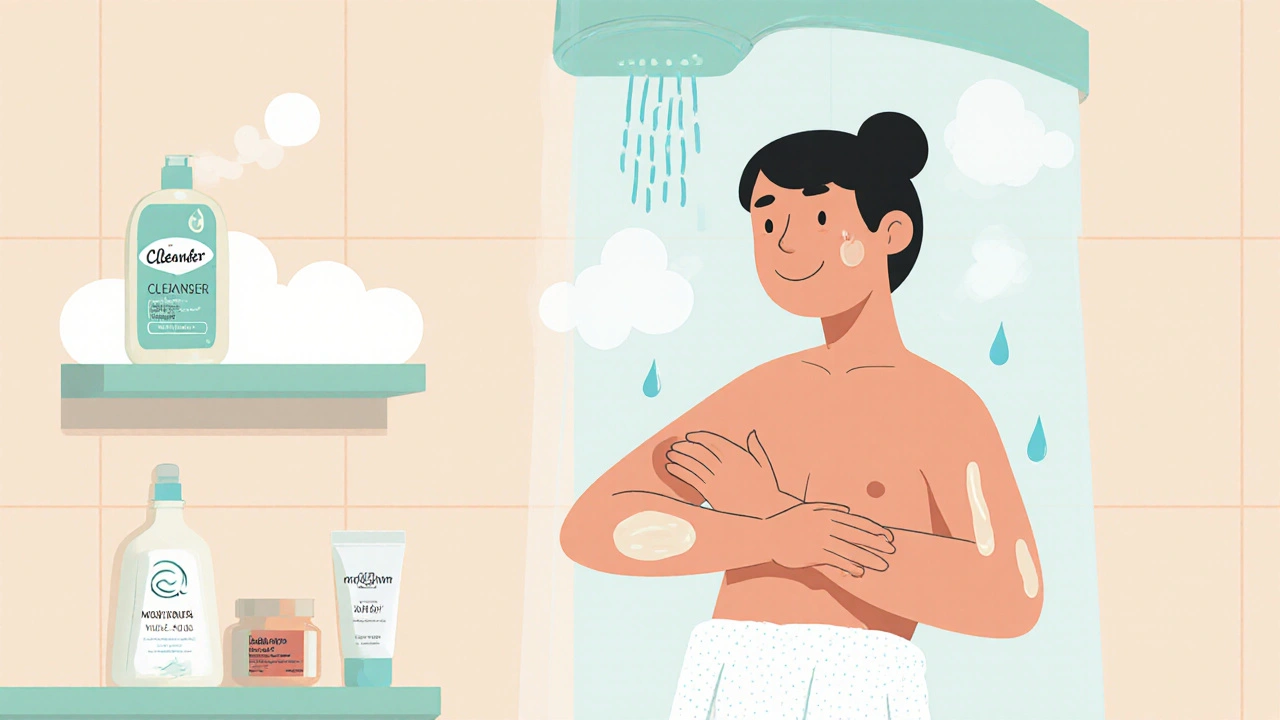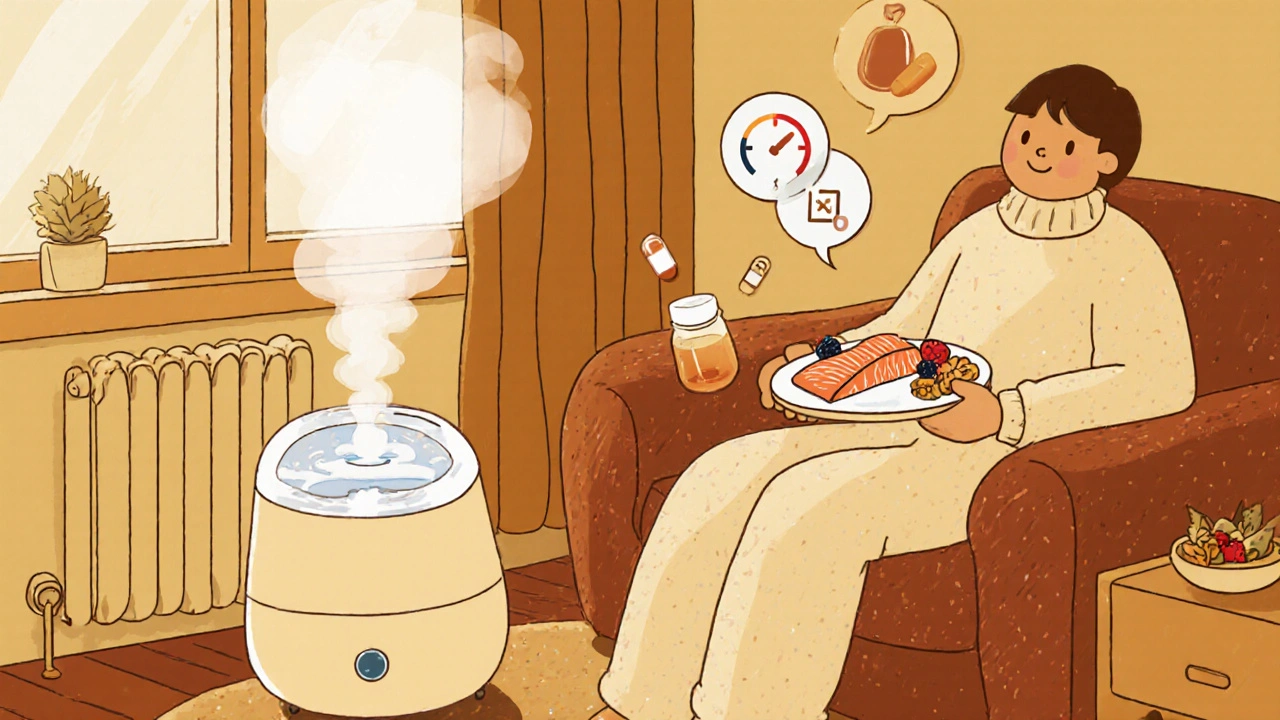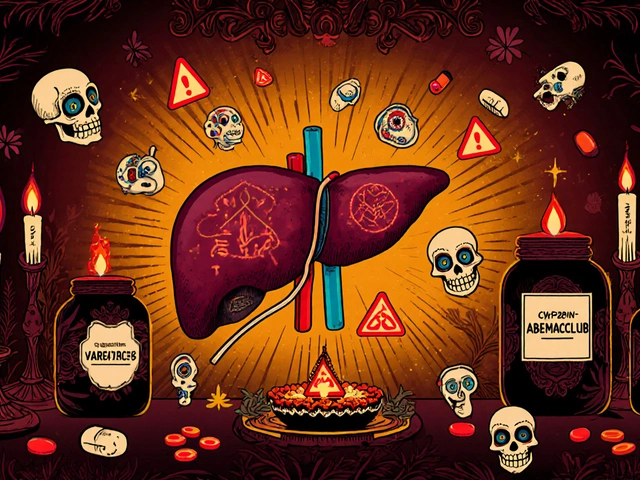
Moisturizer Selection Tool
Select Your Skin Profile
Answer these questions to get personalized moisturizer recommendations for winter psoriasis care.
Moisturizer Type
Key Ingredients
Best For
Application Frequency
When the temperature drops and the air gets dry, many people with Plaque Psoriasis is a chronic autoimmune skin condition that causes red, scaly patches, often on elbows, knees, scalp and lower back notice a sudden flare. The winter months bring a set of challenges that can dry out the skin, trigger itching and make treatments feel less effective. Below is a practical, step‑by‑step plan to keep the flakes at bay, soothe the skin and stay comfortable until spring arrives.
Why Winter Triggers Flares
Cold air, indoor heating and low humidity each strip moisture from the outer skin layer. When the skin barrier loses water, it becomes more permeable, allowing irritants to slip through and set off an immune response. In addition, shorter daylight hours reduce natural vitamin D synthesis, which is thought to play a role in regulating the inflammatory pathways involved in psoriasis.
Strengthen the Skin Barrier
The first line of defence is a well‑hydrated barrier. Follow these three pillars every day:
- Gentle cleansing: Use lukewarm water and a fragrance‑free, sulfate‑free cleanser. Hot showers feel great in winter but they can strip lipids, so keep showers under 10 minutes.
- Immediate moisturising: Pat skin dry and apply a moisturiser within three minutes while the skin is still damp. This traps water and locks it in.
- Seal the deal: For especially dry patches, finish with an occlusive layer (petrolatum or a thick ointment) to prevent evaporation.
Choosing the Right Moisturiser
Not all moisturisers are created equal. Here’s a quick comparison to help you pick the best match for your skin type and lifestyle.
| Type | Key Ingredients | Best For | Application Frequency |
|---|---|---|---|
| Ointment | Petrolatum, lanolin, ceramides | Very dry or cracked skin; night use | 2‑3×day, especially after shower |
| Cream | Glycerin, shea butter, hyaluronic acid | Normal to slightly dry skin; daytime | 2×day |
| Lotion | Water‑based, light oils, aloe vera | Oily skin or when you need quick absorption | 3×day |
For most winter flare‑ups, start with a cream that contains ceramides and add an ointment at night or on the most stubborn plaques. If you prefer a lighter feel during the day, a lotion layered under a thin cream works well.

Adjusting Medications for the Cold Season
Winter doesn’t change the way prescription medicines work, but it can affect how your skin reacts to them. Talk to your dermatologist about these points:
- Topical steroids are anti‑inflammatory creams or ointments used to reduce plaque thickness and itching. You might need a slightly stronger potency for a short period during a flare.
- Biologic therapy is a class of injectable drugs that target specific immune pathways, often used for moderate to severe psoriasis. Ensure your injection site is kept warm and not exposed to extreme cold, which can affect absorption.
- Phototherapy is controlled exposure to UVB light that slows skin cell growth; in winter, many clinics offer home UVB units. If you can’t attend a clinic, discuss portable narrow‑band UVB options.
Never change dosage on your own-always get a professional’s go‑ahead. Small tweaks, like adding a weekend “burst” of a mid‑potency steroid, can keep flares manageable.
Nutrition and Supplements
What you eat won’t cure psoriasis, but certain nutrients can calm inflammation and support skin health:
- Omega‑3 fatty acids (found in fatty fish, walnuts, flaxseed) - studies show up to a 30% reduction in plaque severity when taken regularly.
- Vitamin D - sunlight is limited, so a daily supplement of 1,000-2,000IU is often recommended. Vitamin D is a fat‑soluble vitamin that helps modulate the immune system and supports skin barrier function.
- Antioxidant‑rich foods (berries, leafy greens) help reduce oxidative stress that can aggravate plaques.
Keep a simple food diary for a couple of weeks; you may notice certain triggers (like excess alcohol or processed sugars) that worsen symptoms.
Home Environment Hacks
Indoor heating is a double‑edged sword: it keeps you warm but also dries the air. Follow these three steps to create a psoriasis‑friendly climate:
- Use a humidifier to maintain indoor humidity between 40% and 60%.
- Place a bowl of water near radiators; the water evaporates slowly and adds moisture.
- Avoid direct airflow from heaters or fans on affected skin.
Check humidity levels with a cheap digital hygrometer - it’s a small investment that pays off in fewer dry patches.

Clothing Choices and Daily Habits
What you wear can either trap moisture or strip it away. Opt for soft, breathable fabrics like cotton or bamboo for daily wear. When heading outdoors, layer with a lightweight, breathable inner layer (e.g., a cotton long‑sleeve) and a wind‑proof outer jacket. Avoid wool directly on the skin; it can irritate plaques.
After washing clothes, use a fragrance‑free detergent and skip fabric softeners, which sometimes contain irritants.
Quick Winter Psoriasis Checklist
- Shower with lukewarm water; limit to 10minutes.
- Apply a ceramide‑rich moisturizer within 3minutes of drying.
- Seal the most affected areas with a petrolatum‑based ointment at night.
- Keep indoor humidity at 40‑60%.
- Take 1,000IU vitamin D daily (or as advised by your doctor).
- Include omega‑3 sources in meals 3-4times a week.
- Review medication plan with your dermatologist before the season starts.
- Choose soft, breathable clothing; avoid direct wool contact.
Frequently Asked Questions
Can I use the same moisturiser year‑round?
A richer, occlusive product works best in winter, while a lighter cream or lotion is usually sufficient in summer. Switching helps your skin stay balanced without over‑loading it.
Do heating systems worsen psoriasis?
They dry the air, which can thin the skin barrier. Using a humidifier or placing water containers near radiators mitigates this effect.
Is it safe to increase my steroid potency in winter?
Short‑term use of a higher‑potency steroid is often recommended for flare control, but only under a dermatologist’s guidance to avoid thinning skin.
How much vitamin D should I take during the dark months?
Many clinicians suggest 1,000-2,000IU daily for adults with psoriasis, but a blood test can fine‑tune the exact dose.
Can dietary changes really affect my plaques?
While diet isn’t a cure, reducing processed sugars and adding omega‑3 rich foods can lower overall inflammation and may lessen flare frequency.





There are 8 Comments
Marvin Powers
Well, look at you, dear reader, trying to survive the abyss of winter while your skin decides to throw a plaque party – congratulations on the irony. First, you’ve got to understand that the cold isn’t just a mood swing for the weather, it’s a full‑blown saboteur for your barrier function, sneaking in through every crack you left unmoisturized yesterday. The guide tells you to use lukewarm showers, and honestly, if you’re still blasting the thermostat like it’s a sauna, you’re basically inviting your skin to dry out faster than a desert cactus in a drought. Apply a moisturizer within three minutes of drying – that’s not a suggestion, that’s a command from the dermatological gods who have seen too many cracked elbows. Then seal the deal with an occlusive ointment; think of it as putting a tarp over a leaky roof – you stop the evaporation, you keep the humidity in, and you avoid the indoor‑heater‑induced apocalypse. The section on vitamin D tells you to supplement, but let’s not forget the sun is a free pharmacy that you’re missing because you’re huddled under blankets, so those 1,000‑2,000 IU become your tiny sunrays in a bottle. And if you think “just a bit of fish oil” will solve everything, you’re living in a fantasy novel where the hero wins by eating sushi daily without any other lifestyle changes. Oh, the humidity hack – a humidifier isn’t just a gadget, it’s basically a personal climate engineer fighting the drying villain that is central heating. Remember, the checklist isn’t a random list; it’s a battle plan, and if you skip even one item you’re basically leaving your front door wide open for a flare‑up invasion. Finally, the clothing advice isn’t about fashion; it’s about not turning cotton into sandpaper against your skin, so ditch the wool directly on plaques unless you enjoy the extra irritation. In short, if you follow this guide step by step, you’ll be the winter warrior whose skin stays hydrated, calm, and possibly even Instagram‑ready despite the frost outside.
Shane Hall
Oh wow, this guide really hits the spot! I love how it breaks down the barrier‑strengthening steps with the drama of a winter saga – from gentle cleansers to that glorious sealed‑in‑moisture moment. The detail about applying the moisturizer within three minutes is practically a cliff‑hanger that keeps you on the edge of your bathtub. And don’t even get me started on the vitamin D section – it’s like a secret weapon hidden in a snowflake. Seriously, the humidity hacks feel like an epic side‑quest that you can actually complete with a cheap humidifier.
Christopher Montenegro
While the article presents a superficially comprehensive approach, it suffers from a lack of rigorous clinical substantiation. The recommendation to switch moisturizers seasonally is plausible but not universally validated, as inter‑patient variability remains significant. Moreover, the dosage assertions regarding vitamin D supplementation are presented without reference to serum level monitoring, which is a critical oversight. The suggestion to employ occlusive agents post‑shower, albeit mechanistically sound, neglects the potential for comedogenicity in acne‑prone individuals. In sum, the guidance, though well‑intentioned, requires a more evidence‑based framework.
Kyle Olsen
Allow me to elucidate the obvious: the article’s admonition to avoid hot showers is not merely pedantic, but indeed a cornerstone of epidermal preservation. One must also recognize that the choice of an ointment over a cream is dictated by the lipid‑matrix deficit inherent in psoriatic plaques. It would be remiss not to mention that the humidifier recommendation, though well‑meaning, may prove ineffective in arid climates without proper calibration. Hence, adherence to these protocols necessitates both diligence and discernment.
MANAS MISHRA
The guide does a solid job of outlining practical steps. I particularly appreciate the clear checklist – it makes daily compliance easier. Remember to keep the humidifier clean to avoid mold growth.
Georgia Kille
Great summary! 👍 Stay hydrated and happy skin! 😊
Jeremy Schopper
Excellent article!; however, consider the timing of moisturizer application-ideally within three minutes of patting dry; also, a reminder: avoid fragrance‑laden products; finally, maintain a consistent routine; and, of course, monitor skin response regularly.
liza kemala dewi
Reflecting upon the winter care guide, one cannot help but contemplate the philosophical interplay between external climate and internal equilibrium. The cold air, in its relentless extraction of moisture, mirrors a metaphysical stripping away of superficial comfort, compelling us to seek deeper, more resilient foundations. By employing gentle cleansers, we symbolically purge not only impurities but also the harsh judgments we impose upon ourselves. The subsequent sealing of the skin barrier parallels the human desire to guard one's essential self against invasive negativity. Moreover, the recommendation to augment vitamin D intake invites a discourse on the balance between natural illumination and artificial supplementation, suggesting that even in darkness we can cultivate inner radiance. In essence, the guide transcends mere dermatological advice; it offers a template for cultivating steadfastness amidst adversity.
Write a comment
Your email address will not be published. Required fields are marked *